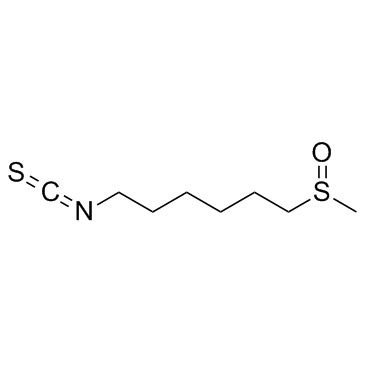| Description |
Hesperin is a bioactive ingredient present in Japanese horseradish (wasabi) and has been shown to be an Nrf2 activator.
|
| Related Catalog |
|
| Target |
Nrf2[1]
|
| In Vitro |
Hesperin (6-Methylsulfinylhexyl isothiocyanate, 6-MSITC) is an active compound in wasabi (Wasabia japonica Matsum.). Whether Hesperin induces cytotoxicity of HUVECs is determined. More than 1 μg/mL of Hesperin markedly induces cytotoxicity and morphological alterations. In subsequent experiments we used Hesperin is used at concentrations of 0-1 μg/mL, to study the anti-coagulant and anti-inflammatory properties of Hesperin in HUVECs[2].
|
| In Vivo |
Hesperin (6-Methylsulfinylhexyl isothiocyanate, 6-MSITC) activates Nrf2 and induces phase II enzyme genes but this induction is absent in Nrf2-null mice, suggesting that Hesperin is a potential activator of the Nrf2/ARE-dependent detoxification pathway. To determine whether Hesperin ameliorates hepatic steatosis and iron accumulation, wild-type and Nrf2-null mice are fed the following diets for 12 weeks: 1) control diet, 2) high-fat diet (HFD), 3) HFD plus Hesperin (10 mg/kg/day ip), 4) HFD for 6 weeks followed by an iron-supplemented HFD for 6 weeks (HFD/Iron), 5) HFD/Iron plus Hesperin. The HFD increased hepatic triglycerides in both genotypes and Hesperin suppress increased hepatic triglycerides in wild-type mice but do not reduce thesetriglycerides in Nrf2-null mice[1].
|
| Cell Assay |
Primary human umbilical vein endothelial cells (HUVECs) are cultured in collagen-coated tissue-culture dishes in an atmosphere containing 95 % air and 5 % CO2. Human monoblast U937 cells are grown in RPMI-1640 medium with 10 % fetal bovine serum, 10 U/mL Penicillin, and 10μg/mL Streptomycin. HUVECs are cultured in collagen-coated 96-well plates as confluent monolayers. Hesperin is added into wells at the indicated final concentrations (0-30 μg/mL) and then incubated for 24 h. Cell viability is measured by cell counting kits[2].
|
| Animal Admin |
Mice[1]A colony of wild-type and Nrf2-null mice are backcrossed with C57BL/6 mice for ten generations. All mice are housed in the same animal care facility controlled for temperature, humidity, and light. Seven-week-old male wild-typeand Nrf2-null mice (n=6-8/group) are divided into five groups fed the following diets: 1) a standard diet (AIN-93, containing 4% soybean oil) for 12 weeks and vehicle (1:10 solution of DMSO/PBS) injected intraperitoneally 4 times per week for the last four weeks (control group), 2) a high-fat diet (HFD) (containing 4% soybean oil and 31% lard) for 12 weeks and vehicle injected intraperitoneally 4 times per week for the last four weeks (HFD group),3) a HFD for 12 weeks and Hesperin (10mg/Kg/day; dissolved in 1:10 solution of DMSO/PBS) injected intraperitoneally 4 times per week for the last four weeks (HFD+ Hesperin), 4) a HFD for 6 weeks followed by a HFD containing 1% carbonyl iron for 6 weeks and vehicle injected intraperitoneally 4 times per week for the last four weeks(HFD+Iron), and 5) a HFD for 6 weeks followed by a HFD containing 1% carbonyl iron for 6 weeks and Hesperin (10mg/Kg/day) injected intraperitoneally 4 times per week for the last four weeks (HFD+Iron+Hesperin). After 12 weeks, blood samples are collected by cardiac puncture under anesthesia with sodium pentobarbital (50 mg/kg, ip) and livers are harvested and stored at -80°C until analysis[1].
|
| References |
[1]. Tanaka Y, et al. 6-Methylsulfinylhexyl isothiocyanate prevents high-fat diet-induced fatty liver but fails to attenuate hepatic iron accumulation in mice. Clin Exp Pharmacol Physiol. 2016 Nov;43(11):1153-1156. [2]. Okamoto T, et al. 6-Methylsulfinylhexyl isothiocyanate modulates endothelial cell function and suppresses leukocyte adhesion. J Nat Med. 2014 Jan;68(1):144-53.
|

